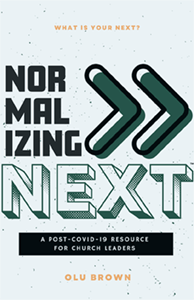Discerning a new vision is only the first step toward congregational renewal and change. Olu Brown outlines four critical steps necessary to make that new vision come alive — convening a team, sharing a new narrative, asking questions, and not being afraid to fail.
When you have discerned and discovered your vision, the next move is to deploy the vision. Another way to say this is to execute the vision. If vision is to be successful, it must transition from the queue or the holding stage to the deployment and execution stage. This part of the vision journey is about the process of executing vision that is all about convening a team, starting a new conversation and narrative, asking questions, and not being afraid to fail.
1. Convening a team
When it comes to vision, never do it alone. In most cases, silo vision does not have the capacity to become a catalyst for change. Consider these following suggestions. You may decide to have a consistent team of people who help you think through vision. The plus to this decision is that you know each other, so you don’t have to spend time getting people up to speed and you can start with everyone in the same place. A second option is to select a different group of people each time you have a vision conversation. Although you will likely spend time at the beginning of the gathering updating people on the history from the previous vision engagement, you will have a new and fresh audience to help you think about vision for the future. There are pros and cons to both approaches, but the good news is that, in either approach, you will be breaking out of the silo vision process and shifting to a communal vision process.
2. Starting a new conversation and narrative
During these vision team meetings, strategically start a new conversation and narrative. For instance, if the meeting is about creating ways to get more teenagers to attend Vacation Bible School, you may have to first address the myth and narrative that teenagers don’t attend Vacation Bible School. There are times when members of the group bring previous narratives and bias into the conversation and new gathering that don’t fit the current vision. They may come with their own predeveloped narratives about teenagers and what teenagers may or may not do. It is important that you address these predeveloped narratives early on by starting a new conversation, such as “Today, we are going to talk about getting more teenagers to attend Vacation Bible School because the spiritual health of our teenagers is important, and we have been blessed to be surrounded by young people in our community.”
3. Asking questions
Great conversations typically begin with curiosity and questions. Curiosity comes into play at the beginning of the gathering. Each of the group members should be genuinely curious about the topic of discussion and feel they are in a safe place to offer suggestions and, most importantly, ask questions. Some of the best recommendations and questions are never presented or asked because people may feel intimidated or feel that their suggestions or questions don’t matter to the group. Here are a few starter questions to consider:
- If there were no limitations, what would we do?
- Who can help us to achieve the vision we are developing?
- As we clarify the vision, who or what is our target audience?
- How can your skills and talents help us execute the vision?
4. Not being afraid to fail
I saved the best for last. When it comes to vision planning and vision execution, failure is normal and to be expected. I know this sounds weird, but you build failure and missteps into your vision plans because no vision is executed without issues. Perhaps you are open to the wisdom of Edwin Freeman, whose work has helped me over the years, especially his book, A Failure of Nerve. He said the following about leadership, “To be a leader, one must both have and embody a vision of where one wants to go. It is not a matter of knowing or believing one is right; it is a matter of taking the first step.” Taking the first step isn’t easy or popular, and you will often have to challenge yourself to make many first steps. But failure and falling are imminent for every leader with a vision.
I have never had a time when I served in the church and convened vision meetings when everything worked out 100%. Not to discourage you, but there will always be something or someone getting in the way of vision execution. In some cases, it is due to a lack of clarity, resources, skills needed, and the biggest factor of them all is time. I don’t believe I have ever felt I had enough time to properly execute a vision. When I was a pastor, I felt we were building the plane in the air and constantly needed more time to land the vision. Even when all the stars, people, and resources align in the right direction, failure may still be imminent because it may not have been meant to occur at that particular time and place. There are also times when we are tasked to begin the vision and not finish the vision. We may also see this as failure. If you are going to be a visionary leader, you will have to become comfortable with failure. Then, each time you fail, not see it as a setback but an opportunity to continue growing and thriving and reaching new heights.
 This material is adapted from Normalizing Next: A Post COVID-19 Resource for Church Leaders by Olu Brown. (Culverhouse LLC, 2022). The book is available at Amazon.
This material is adapted from Normalizing Next: A Post COVID-19 Resource for Church Leaders by Olu Brown. (Culverhouse LLC, 2022). The book is available at Amazon.
Related Resources
- Discovering God’s Future For Your Church, a video tool kit for congregational visioning
- Two Views of Vision by Lovett H. Weems Jr.
- 5 Steps for Putting Good Ideas into Action by Jim Hoffman
If you would like to share this article in your newsletter or other publication, please review our reprint guidelines.






